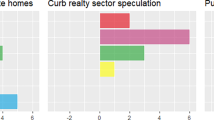Abstract
This paper proposes a new explanation for housing rent price rigidity. When high inflation or low inflation occurs, the bargaining process for new rent price represents negotiations representing increasing or diminishing utility for landlords. Based on framing effect theory, this study hypothesized that utility increasing-bargaining causes landlords to choose to give greater concessions and prefer short-term contracts. Although the income obtained from single contracts is comparatively lower, the high transaction volume (number of lease contracts) causes a reduction in the number of vacant properties and a higher frequency of price adjustments. Conversely, when low inflation occurs, landlords face utility decreasing-bargaining, reduce their concessions, and exhibit a preference for long-term contracts, thereby leading to an increase in the number of vacant houses and a lower frequency of price adjustments. Using US rental market data, this study explains asymmetric rent volatility and changes in the vacancy rate, and provides related evidence supporting the hypothesis that this rental market phenomenon is caused by an inflation illusion.






Similar content being viewed by others
Notes
For more information, please visit http://www.bis.org/statistics/cp.htm/.
For more information, please visit https://www.census.gov/housing/hvs/data/histtabs.html/.
References
Alchian, A. A., & Allen, W. R. (1982). Exchange and production: Competition, coordination, and control. Belmont: Wadsworth.
Balke, N. (2000). Credit and economic activity: Credit regimes and nonlinear propagation of shocks. Review of Economics and Statistics, 82, 344–349.
Baqaee, D. R. (2019). Asymmetric inflation expectations, downward rigidity of wages, and asymmetric business cycles. Journal of Monetary Economics, In press. https://doi.org/10.1016/j.jmoneco.2019.04.014.
Bar-Isaac, H., & Gavazza, A. (2015). Brokers’ contractual arrangements in the Manhattan residential rental market. Journal of Urban Economics, 86, 73–82.
Belsky, E., & Goodman, J. L. (1996). Explaining the vacancy rate - rent paradox of the 1980s. Journal of Real Estate Research, 11(3), 309–323.
Cheung, Y., Tsang, S., & Mak, S. (1995). The causal relationships between residential property prices and rentals in Hong Kong: 1982–1991. Journal of Real Estate Finance and Economics, 10, 23–35.
Davis, M. A., Lehnert, A., & Martin, R. F. (2008). The rent-price ratio for the aggregate stock of owner-occupied housing. Review of Income and Wealth, 54(2), 279–284.
Engelhardt, G. V. (2003). Nominal loss aversion, housing equity constraints, and household mobility: Evidence from the United States. Journal of Urban Economics, 53, 171–195.
Fehr, E., & Tyran, J.-R. (2001). Does money illusion matter? American Economic Review, 91(5), 1239–1262.
Furth-Matzkin, M. (2017). On the unexpected use of unenforceable contract terms: Evidence from the residential rental market. Journal of Legal Analysis, 9(1), 1–49.
Gabriel, S., & Nothaft, F. E. (1988). Rental housing markets and the natural vacancy rate. Real Estate Economics, 16(4), 419–429.
Gabriel, S., & Nothaft, F. E. (2001). Rental housing markets, the incidence and duration of vacancy, and the natural vacancy rate. Journal of Urban Economics, 49(1), 121–149.
Genesove, D., & Mayer, C. (2001). Loss aversion and seller behavior: Evidence from the housing market. Quarterly Journal of Economics, 116, 1233–1260.
Genesove, D. (2003). The nominal rigidity of apartment rents. Review of Economics and Statistics, 85(4), 844–853.
Goodhart, C. (2001). What weight should be given to asset prices in the measurement of inflation? Economic Journal, 111(472), 335–356.
Hoffmann, J. & Kurz-Kim, J.-R. (2006). Consumer price adjustment under the microscope: Germany in a period of low inflation. Discussion paper series 1: Economic studies 2006, Deutsche Bundesbank Research Centre.
Kashiwagi, M. (2014). A search-theoretic model of the rental and homeownership markets. Journal of Housing Economics, 26, 33–47.
Levin, I. P., Schneider, S. L., & Gaeth, G. J. (1998). All frames are not created equal: A typology and critical analysis of framing effects. Organizational Behavior and Human Decision Processes, 76(2), 149–188.
MacKinnon, J. G. (1996). Numerical distribution functions for unit root and cointegration tests. Journal of Applied Econometrics, 11, 601–618.
Miceli, T. J., & Sirmans, C. F. (2013). Efficiency rents: A new theory of the natural vacancy rate for rental housing. Journal of Housing Economics, 22(1), 20–24.
Muller, R. (1991). Rent control and vacancy rates in Canada. QSEP research report 275, McMaster University.
Neale, M. A., & Bazerman, M. H. (1985). The effects of framing and negotiator overconfidence on bargaining behaviors and outcomes. Academy of Management Journal, 28(1), 34–49.
Phillips, P. C. B., Shi, S., & Yu, J. (2015). Testing for multiple bubbles: Historical episodes of exuberance and collapse in the S&P 500. International Economic Review, 56, 1043–1078.
Rosen, K. T., & Smith, L. B. (1983). The price-adjustment process for rental housing and the natural vacancy rate. American Economic Review, 73(4), 779–786.
Shilling, J. D., Sirmans, C. F., & Corgel, J. B. (1987). Price adjustment process for rental office space. Journal of Urban Economics, 22(1), 90–100.
Shimizu, C., Nishimura, K. G., & Watanabe, T. (2010). Residential rents and price rigidity: Micro structure and macro consequences. Journal of the Japanese and International Economies, 24(2), 282–299.
Tversky, A., & Kahneman, D. (1986). Rational choice and the framing of decisions. Journal of Business, 59(4), 251–278.
Vogelsang, T. J. (1993). Essays On Testing for Nonstationarities and Structural Change in Time Series Models. Unpublished Ph.D. Dissertation, Princeton University, Princeton, NJ.
Vogelsang, T. J. (1997). Wald-type tests for detecting breaks in the trend function of a dynamic time series. Econometric Theory, 13(6), 818–849.
Wheaton, W. C., & Torto, R. G. (1994). Office rent indices and their behavior over time. Journal of Urban Economics, 35(2), 121–139.
Acknowledgments
I am immensely grateful to Professor James B. Kau (Editor-in-Chief) and the anonymous referee for the constructive comments of this paper. Funding from the Ministry of Science and Technology of Taiwan under Project No. MOST-107-2410-H-390-016-MY3 has enabled the continuation of this research and the dissemination of these results.
Author information
Authors and Affiliations
Corresponding author
Additional information
Publisher’s Note
Springer Nature remains neutral with regard to jurisdictional claims in published maps and institutional affiliations.
Rights and permissions
About this article
Cite this article
Tsai, IC. Price Rigidity and Vacancy Rates: The Framing Effect on Rental Housing Markets. J Real Estate Finan Econ 63, 547–564 (2021). https://doi.org/10.1007/s11146-020-09791-4
Published:
Issue Date:
DOI: https://doi.org/10.1007/s11146-020-09791-4




